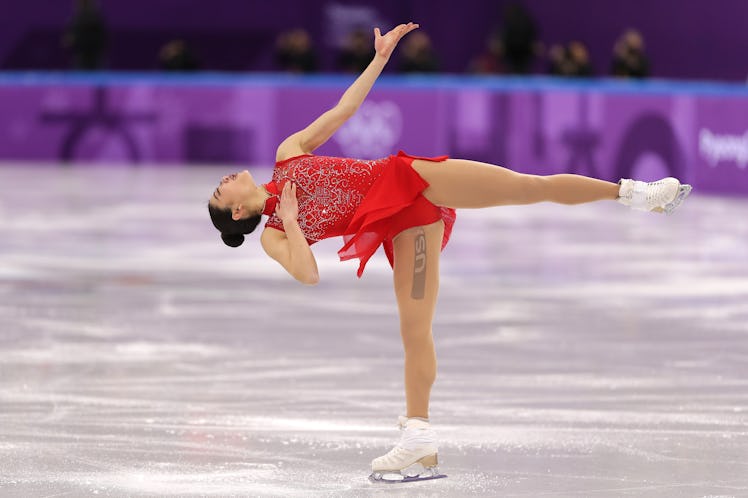
This Is How Figure Skaters Avoid Feeling Dizzy While They're Out On The Ice
The Winter Olympics are in full swing, and if you've been keeping up with the competitions, you're likely in sheer awe of the incredible skills and talent of these hard-working athletes. Personally, I find myself constantly holding my breath during the figure skaters' elaborate, twirly routines, and the speedy rotations of their entire bodies in midair. Seriously, how figure skaters don't get dizzy while they're out there on the ice is beyond me, because I personally believe I'd 100 percent pass out or throw up on the spot — or both. Just sayin'.
Think about it: It doesn't take all that much to feel dizzy. Obviously, everyone's different, but I, for one, get nauseously dizzy even when I casually spin myself around in a desk chair. Your edge might be the teacup ride at an amusement park. I don't know your life.
Well, to state the obvious, figure skaters move a lot faster than a spinning ride at the county fair. According to a BuzzFeed video, these elegant athletes can rotate as fast as 402 revolutions per minute during the most challenging of jumps. For perspective, according to the video, that's the same speed as a Toyota Prius wheel spinning at 30 miles per hour. Damn.
So, if skaters are literally twirling at the speed of a quickly rotating automobile wheel, how the hell do they avoid getting dizzy?
According to Scientific American, it all begins with the vestibular system, which is located in your inner ear, and helps keep you upright throughout the day. Basically, when you spin your body, your eyes begin moving in the opposite direction in an attempt to follow the spinning motion, but your eyes cannot complete the journey that a 360-degree turn requires. This causes your eyes to return to their starting position, and this repeats over and over as you spin. Cue inevitable dizziness and motion sickness galore.
Now, there's a technical term for that back-and-forth motion of your eyes; it's called nystagmus, but it's not just a way to refer to what your eyes do when you're spinning and get dizzy. According to the American Optometric Association, nystagmus is "a vision condition in which the eyes make repetitive, uncontrolled movements," which can "result in reduced vision and depth perception and can affect balance and coordination."
But Olympic figure skaters are actually taught to go against any sensations of nystagmus by activating optokinetic nystagmus, which is basically just a fancy way of saying that they try to have their eyes keep track of and focus on a single point while they're spinning.
While dancers keep their eyes locked on a fixed point during twirls to help minimize the feelings of dizziness, figure skaters simply rotate too fast to do this.
Instead, they pick something on the ice to focus on, and try to catch a glimpse of it every time they spin. This helps decrease overall feelings of dizziness, and according to New York Daily News, it also assists them in keeping track of the number of rotations they're performing, so they can be sure that they're executing their routine correctly.
Figure skaters also practice specific breathing exercises during their training sessions for their spins and jumps, because deep inhales and exhales help them overcome the initial feelings of nausea and motion sickness.
However, figure skaters are, of course, still human, and that means that they do still get dizzy while they're out on the ice; they've just learned how to get used to the feeling, with practice.
According to TODAY, skaters actually don't feel dizzy when they're in the climax of a challenging spin. They typically feel dizziest at the beginning of tricky twirls (when they're not used to the sensation), and toward the end (when their bodies keep their ear canal fluid moving, even though they've stopped spinning).
A trick that skaters' coaches apply to help skaters recover more quickly from the dizziness, according to TODAY, is including more low-key dance choreography right after difficult balances and fancy jumps. Basically, a figure skater will almost never go from, say, one triple axel, immediately into another one. That would be a recipe for a dizzy disaster, my friends.
I'm glad that the skaters and their coaches have these strategies in place, because TBH, I'm getting dizzy just watching them from my living room couch.
Erin Jackson is an inline skating world medalist and roller derby MVP. She dreamed of skating in the Olympics, but to do that, she had to get on ice. She took her first steps on a long-track course in 2016 and started training professionally in September 2017. Four months later, she qualified for the Olympic Winter Games. Check out Elite Daily Insights' video on Jackson's incredible story: